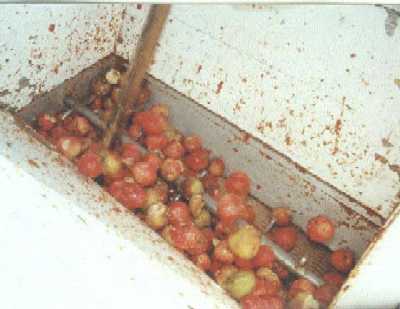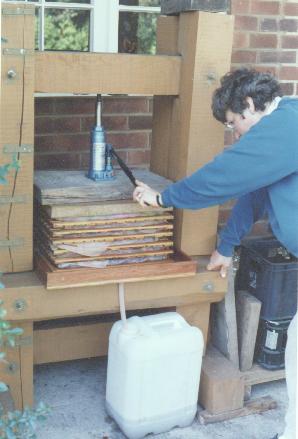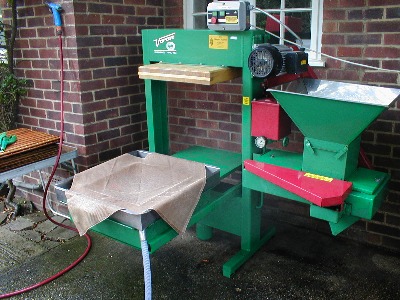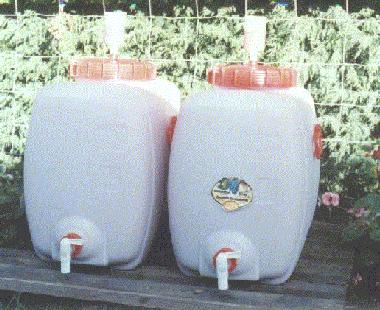 Milling
Milling Milling
Milling As
soon as the trees started to bear fully (about half a ton annually) I
needed
a proper mill, so in 1993 I bought one at auction from a local winery
(Westbury
vineyard near Reading) which was selling up all its stock after the
death
of its owner (Bernard Theobald).
As
soon as the trees started to bear fully (about half a ton annually) I
needed
a proper mill, so in 1993 I bought one at auction from a local winery
(Westbury
vineyard near Reading) which was selling up all its stock after the
death
of its owner (Bernard Theobald).
Here's me (in a picture taken by Roy Bailey) feeding the mill with the first pass of fruit. You can see some other cider kit in the background too.
The mill itself is a German (Amos) grape crusher dating from 1964 and not ideally suited to apples. It has a pair of contrarotating ridged rubber rollers which are geared together and beltdriven from a 1.5 kw electric motor via a flywheel. The spacing between the rollers is adjustable, which is just as well because for crushing apples it's necessary to make four or five passes through the mill, progressively closing the roller gap on each pass.
 The
first pass is the most difficult because the apples are still intact.
Although
there's a driven set of stainless steel 'fingers' on a shaft situated
above
the rollers, a great deal of manipulation with a stout wooden stick is
also required to ensure that all fruit is initially crushed through the
rollers.
The
first pass is the most difficult because the apples are still intact.
Although
there's a driven set of stainless steel 'fingers' on a shaft situated
above
the rollers, a great deal of manipulation with a stout wooden stick is
also required to ensure that all fruit is initially crushed through the
rollers.
The pulped fruit is collected in a plastic box placed under the mill, and its contents then re-introduced to the top of the mill for the next pass.
Here in close-up you can see the fruit, the wooden stick, the rollers and the steel 'fingers'.
Although this system served us well for 5 years, it did consume a lot of time and effort because of the need to make multiple passes to break the fruit down sufficiently. Amos couldn't supply replacement 'grater' rollers and I could find no way of converting the existing rubber ones.
I've now (summer 1998) invested in a centrifugal apple mill designed for European 'hobby' producers which I bought from Alex Hill of Vigo Vineyard Supplies in Devon. This should be much faster and produce a much finer pulp via its rotating knife and screen arrangement. Later note - now (2005) that I have a fully automated mill and press system (see below), I sold the centrifugal mill on to my friend Roy Bailey.
 Pressing
PressingBasically it's a stout frame of timbers on
which
a set of 'cheeses' can be built up for expression of the juice using a
hydraulic 'bottle jack' as the motive power. The original design is for
4" x 4" hardwood timbers and a 12" square cheese bed, but I expanded
mine
to use 6" x 6" timbers and a 16" cheese. This is because I wanted a
greater
throughput and I also had access to some ash timbers of that size.
They'd
been sawn and seasoned for me by a local tree surgeon and timber
merchant
when he felled some ash for me which had to come out when we built an
extension
on our house. So there was a sentimental reason for using that timber
too!
The joinery was by chainsaw and the frame is reinforced with threaded
bolts
and metal plates, so it's not very pretty if you start to look too
closely
- but it's done the job now for the last six years so I'm not
complaining!
The timber was finished in a non-toxic water-based wood preservative of
the modern resin type (not old-fashioned creosote since we don't want
tainted
cider!).

The racks I made from hardwood laths and chrome plated screws, well covered in polyurethane sealer. The juice tray is made of marine ply and likewise well coated with yachtgrade PU sealer. The press cloths are cheap nylon net curtaining bought from a drapery store in Oxford they've lasted at least 5 seasons but now need replacement. I've progressed through three bottle jacks (1, 4 and finally 8 tons), the latter being a secondhand bargain which I came upon by chance in an Oxford surplus store and couldn't bear to pass by. The frame creaks a bit when the full eight tons is applied, but it seems to take it. I wouldn't like to go any more than this, though, for fear of splitting the frame!
The picture here shows us building up a
cheese.
The pulp is being scooped up from the grey plastic tub which was
previously
under the mill, and is spread out in the press cloth using a wooden
'form'
to keep it central on the rack. The cloth is then folded over, the next
rack added on top, and the process repeated. A typical load is six or
seven
cheeses from about 3 boxes of fruit (40 kg). This gives about 25 litres
of juice or a yield of about 60%, but the actual yield depends on the
firmness
of fruit and the fineness of the mash. A proper hydraulic pack press
would
probably give a 10% greater yield, simply because of the harder squeeze.
 The
free-run juice comes out pretty quickly, but pressing goes on for an
hour
or two to get as much yield as possible, and the total turnaround time
to include making up the cheese and stripping it down again is in the
order
of two to three hours depending on what else we're doing in the
meantime.
As the juice is squeezed out, and the jack piston reaches the end of
its
travel, we have to replace the lost volume with 'packs' of hardwood or
faced high-density fibreboard (we use a PU-sealed offcut from a kitchen
worktop as a top-pressure plate!). Everything's hosed down with clean
water
immediately afterwards because once the pulp or juice has dried on it's
the very devil to remove! The compressed 'sheets' of pomace we
occasionally
wet and re-press if we need the yield, but generally they are broken up
roughly and go straight for composting with alternating layers of lime
to keep them 'sweet'.
The
free-run juice comes out pretty quickly, but pressing goes on for an
hour
or two to get as much yield as possible, and the total turnaround time
to include making up the cheese and stripping it down again is in the
order
of two to three hours depending on what else we're doing in the
meantime.
As the juice is squeezed out, and the jack piston reaches the end of
its
travel, we have to replace the lost volume with 'packs' of hardwood or
faced high-density fibreboard (we use a PU-sealed offcut from a kitchen
worktop as a top-pressure plate!). Everything's hosed down with clean
water
immediately afterwards because once the pulp or juice has dried on it's
the very devil to remove! The compressed 'sheets' of pomace we
occasionally
wet and re-press if we need the yield, but generally they are broken up
roughly and go straight for composting with alternating layers of lime
to keep them 'sweet'.
The juice is then tested for sugar (specific
gravity
by hydrometer and/or percent sugar by hand-held refractometer) and for
pH. It's then bulked and blended as required, treated with sulphur
dioxide
as necessary, and yeasted next day if that's appropriate. We ferment
and
store in 60 litre polythene Speidel or Graf tanks (shown below) which
are
made in Germany for 'hobby' winemakers and again obtained from Vigo
in Devon. They're ideal for our sort of scale (maximum 400 litres per
annum),
light and easy to clean with large top apertures for proper internal
access.
The 60 litre size can also be moved by two people when full, without
the
handles breaking! We always ferment outside to keep things cool. If the
temperature does drop below freezing for a day or two it's only by a
few
degrees and does no damage even if the contents set solid for a while!
Generations of English and French cidermakers have been doing it this
way
with no problems - though it would be different in a harsher climate,
of
course!
 All
the above is a bit out of date now. A couple of years ago I acquired a
secondhand Voran combined scratter mill and and pack press (seen on the
left). It works from a single electric motor which powers the
press hydraulics and/or the mill via a rather cunning ratchet device
depending on the direction of rotation of the motor. This is
obviously a lot more efficient than the arrangement described
above. More details later when I have time to write it up fully.
All
the above is a bit out of date now. A couple of years ago I acquired a
secondhand Voran combined scratter mill and and pack press (seen on the
left). It works from a single electric motor which powers the
press hydraulics and/or the mill via a rather cunning ratchet device
depending on the direction of rotation of the motor. This is
obviously a lot more efficient than the arrangement described
above. More details later when I have time to write it up fully.
 On
the following page you can find some
details
of actual fermentations from the 1997/98 season, as typical examples of
what happens next.
On
the following page you can find some
details
of actual fermentations from the 1997/98 season, as typical examples of
what happens next.
Click here to go forward to 'Fermentation and Storage'
Click here to go back to 'Andrew's Orchard'
Or here to go back to my 'Contents Page'
Last updated 22 November, 2006